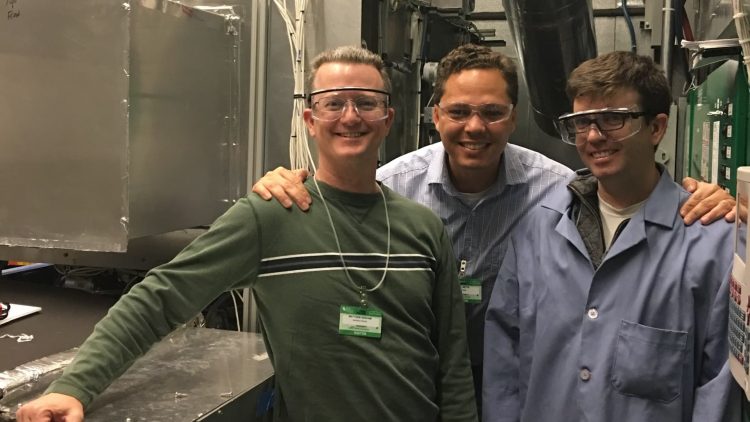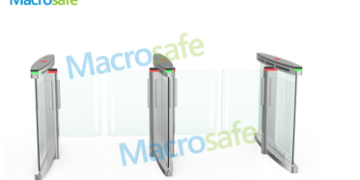The Blue Frontier founding team testing a prototype at Oak Ridge National Labs. From left to right: Matt Graham (VP of Engineering), Daniel Betts (CEO) and Matt Tilghman (CTO).
Air conditioning has the potential to keep people cool as climate change keeps making the planet hotter. At the same time, conventional air conditioning technology uses a lot of energy, meaning it’s contributing to climate change — and will have a bigger effect as more people need air conditioners to stay comfortable or even survive.
Currently, air conditioning is responsible for nearly 4% of global greenhouse gas emissions, according to an analysis by scientists from the Department of Energy’s National Renewable Energy Laboratory and Xerox’s Palo Alto Research Center released in March. Those emissions are expected to get worse as more people install air conditioners, especially in India, China, and Indonesia, according to a joint statement from the NREL and Xerox PARC.
“It’s a good and a bad thing,” Jason Woods, an NREL senior research engineer and co-author of the new study, said in a statement about the research. “It’s good that more people can benefit from improved comfort, but it also means a lot more energy is used, and carbon emissions are increased.”
Conventional air conditioner technology uses a vapor compression cycle to cool the air. In that system, refrigerant is used to do the cooling.
Chlorofluorocarbons and hydrochlorofluorocarbons used to be part of the most common refrigerants in air conditioners, but those chemicals deplete the ozone layer and they’re being phased out. There are a couple dozen alternatives that don’t harm the ozone layer, but they still have a high global warming potential.
In addition, a lot of energy in a conventional air conditioner is used to over-cool the air in order to make it less humid and more comfortable.
Read more about energy from CNBC Pro
Of the 1,950 million tons of carbon dioxide released each year from the energy used to power air conditioning, 531 million of those tons are to cool the air and 599 million tons are to remove the humidity, according to the NREL and Xerox PARC research. An additional 820 million come tons from the leakage of refrigerants and from greenhouse gasses emitted during the manufacturing and transporting of the air conditioner units.
“We’ve already made the existing, century-old technology nearly as efficient as possible,” Woods said in the statement. “To get a transformational change in efficiency, we need to look at different approaches without the limitations of the existing one.”
That’s the goal of Blue Frontier. The startup is working on technology that will make air conditioning more efficient with fewer harmful environmental by-products, and just scored a $20 million round led by Bill Gates investment fund, Breakthrough Energy Ventures.
It started with anthrax
Blue Frontier uses one-third to one-fifth the amount of refrigerants that would be required for a conventional system, and because the construction of the machine is different than a conventional air conditioner, it can use a refrigerant with a lower global warming potential. “The combined effect is an 85% to 87% reduction in our system’s contribution to global warming,” CEO Daniel Betts told CNBC.
The technology was actually discovered in efforts to kill airborne anthrax, which is a potential bioterrorism weapon, according to Betts. It’s based on liquid desiccants, which are chemicals with a lower level of vapor pressure than water. When humid air is passed over that liquid desiccant, the water is pulled out, dehumidifying the air.
“Liquid desiccants are excellent antiseptics and bactericides. So the contact of anthrax with the liquid desiccant would kill it. This initial research led to innovations and discoveries that form the basis of Blue Frontier’s technology,” Betts told CNBC. “In fact, one of the advantages of Blue Frontier air conditioning technology would be a general improvement of indoor air quality and a healthier indoor environment.”
Zoom In IconArrows pointing outwards
The Blue Frontier system getting tested at the National Renewable Energy Laboratory.
Courtesy Blue Frontier
Some refrigerant is used in the Blue Frontier system but it is not used to do the cooling, it is used for operating the heat pump that regulates the salt concentration of the desiccant.
“Thus, the refrigerant and refrigerant carrying equipment never meets air entering the building or the interior of the building,” Betts told CNBC. “This gives us an enormous advantage to use readily available refrigerants that are mildly flammable, without putting at risk the safety of the people in the building.”
Air conditioners that store energy, too
The liquid desiccant that Blue Frontier uses can be stored inside the air conditioning machine in a small plastic tank, essentially storing the cooling capacity to be used when it’s most needed. That’s critical for a decarbonizing grid that will be increasingly dependent on renewables, like wind and solar, which are both intermittent sources of energy.
“The storage also allows us to consume the bulk of our energy when renewable energy is abundant and when electric grid congestion is low. We avoid consuming electricity during peak demand periods that are powered by fossil fuel peaking plants,” Betts told CNBC.
“Summer peak demand is not just a problem because it causes brown-outs, it increases the cost of electricity, and produces more greenhouse gas emissions. It is also a cause of forest fires. When everyone consumes electricity for air conditioning during the hottest days of the year, the large amount of electricity flowing through the transmission and distribution lines heats them up and makes them sag,” said Betts. “This increases the probability that they will come in contact with vegetation, causing forest fires.”
For VoLo Earth Ventures, another investor in the round announced Thursday, that storage capacity is also a key reason why Blue Frontier’s solution is attractive.
“Blue Frontier’s technology is a game changer for both cooling decarbonization and grid efficiency,” Kareem Dabbagh, co-founder at VoLo Earth Ventures, said in written statement. “Their intersection of novel cooling technology and energy storage enables new opportunities to flatten large afternoon grid peaks in cooling demand, saving money for consumers and utilities.”
Zoom In IconArrows pointing outwards
The prototype for the Blue Frontier air conditioner.
Photo courtesy Blue Frontier.
Learning from past mistakes
Before launching Blue Frontier, Betts launched another air conditioner start-up, Be Power Tech, which aimed to commercialize technology that both was an air conditioner and a source of energy. The startup failed, and Betts learned that building a company on two technologies that aren’t yet developed is too much.
“I made the cardinal mistake of technology startups which is I put two completely new technologies dependent on each other and merged them,” Betts told CNBC. “So, double the risk, double the money required. And so that company did not do that great.”
But he learned a lot about launching a product into a market that will be adopted and used.
“The insight was that we need to do something that does not change how people interact with the air conditioner in the building,” Betts said. “To the installer, and to the builder, or to the building owner, it should just be a replacement or conventional air conditioner with ours.”
So that is what Betts and his team is trying to do.
They’re taking the technology, which has been been proven in prototypes tested at National Renewable Energy Laboratory and at Oak Ridge National Laboratory, and scale it up for commercial buildings first.
Some test units will be installed in buildings in 2022, and another round of pre-commercial units are expected to go into buildings in 2023 and then the first commercial product for commercial buildings will be available in 2025. And if all goes well, a residential product will be on the market by 2026 or 2027, Betts told CNBC.
Source by www.cnbc.com






























